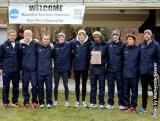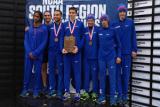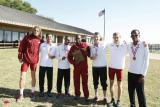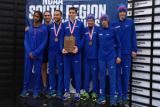FoldersFeatured 89
Results 642
Previews 38
News 33
Webcast Info 86
Awards 20
Entries 174
Team Recaps 32
Rankings 50
RRW 18
USTFCCCA.org D1 197
Big Ten 0
huskers.com T&F 126
Big 12 0
Big Sky 0
Big West 0
C-USA 0
Colonial 0
Horizon 0
Ivy 0
MAAC 0
MAC 0
gozips.com T&F 118
MEAC 0
themwc.com T&F 614
NEC 0
Pac-12 3
goducks.com T&F 122
Patriot 0
SEC 0
SoCon 0
Sun Belt 0
SWAC 0
WAC 0
USTFCCCA.org D2 148
All 86356
|
D1 Regional Summary November 15 - NCAA D1 Cross CountryPublished by
This weekend we had NCAA qualifying meets in Division 1. All of the main teams made the meet. There were a few surprises and the Mountain Region men’s team race was impressive and may have given us a view into how the NCAA meet will turn out. The toughest place to get an automatic qualifier this weekend was definitely the Mountain Region men’s race. Not only did it have four teams ranked in the top 11 and six ranked in the top 26 but they ran at altitude in Ogden, Utah over the rarely run distance of the season at 10k. There was no major concern about an automatic top-two qualifying position since all of the top 11 teams had been successful during the regular season and if they dropped to fourth they would still get one of the 13 at-large bids. Pre-meet #2 Northern Arizona showed their ability to run as a pack up front (took 3rd and 9-11), similar to the tactics that have made Oklahoma State successful. Kennedy Kithuka of Texas Tech (29:23) kept his cross country winning streak going and beat individual contender Anthony Rotich of UTEP (29:39). The Lumberjacks edged #1 Colorado 61-69 as they ran as a pack early and dissolved slowly behind Northern Arizona. #11 New Mexico was third with 79 and #6 BYU welcomed back senior Jared Ward who finished fourth to lead them to 109 points. Fifth place #29 Air Force and sixth place #23 Colorado State were also offered at-large bids. Northern Arizona was moved to #1 when the rankings came out on Monday. The most top-heavy regional had to be the West Regional meet. #1 Arizona women had won Roy Griak, Pre-Nationals and Pac-12 meets this year. What Arizona continued to show was their ability to run fast as a group up front (like Providence). While individuals were running up at front to get one of the four individual qualifying spots Arizona, Kibet, Beattie, Larsson and Corbin finished 8-9-10-12 but #5 was 45th. Stanford’s Aisling Cuffe (3rd) and Jessica Tonn (6th) ran in front of Arizona runners and placed 3-5 (20-26-39) before Arizona’s #5. Arizona beat #18 Stanford 84-94 with #15 Oregon (120) #17 San Francisco (140), #12 Washington (162) and #26 Arizona State (175) as #25 Boise State (300) finished tenth in a very tough Regional. The first five made the NCAA meet as ASU oddly did not. Two likely NCAA top-ten finishers, Boise State’s Emma Bates (19:11) and ASU’s Shelby Houlihan (19:14) had to race among the leaders to ensure an NCAA invitation. They finished just ahead of Pac-12 champion Cuffe (19:15). #4 Oregon Men had some questions moving into the West Region meet with two freshmen and a miler as part of their top five but Oregon ran well early and had the lead with Senior 10k track all-American Parker Stinson and PAc-12 champion Edward Cheserek in the early lead. #6 Stanford caught the Ducks and the top three late in the team race and won with 53 to 64 for Oregon, #10 Portland was third with 92, #32 Boise State fourth with 117 and #28 ASU fifth with 184. Ranked 20th as recently as October 22nd, the Broncos (2nd at Bill Dellinger and 8th at pre-Nationals) were left out of the NCAA meet. Freshman Cheserek won another race (only lost pre-Nationals) as the distance moved to 10k (29:35). He finished ahead of the fast closing Jim Rosa (29:43) and Eric Olson (29:48) of Stanford. Both the men’s and women’s races at the Northeast Regional had interesting battles among top teams. ACC champion #14 Syracuse (57) beat Ivy league champ #8 Columbia (78) and MAAC champion #7 Iona (81) with all teams close as #21 Providence was fourth at 90, #26 Dartmouth was fifth with 101. Sixth place #33 Harvard was back at 155 and were led by Region champ Maksim Korolev in 30:11 ahead of Matt Gillespie of Iona in 30:18. All six teams made the NCAA meet. #2 Providence again showed their legitimate claim to favorite over the 6k distance for the NCAA meet as they dominated a strong field in the Northeast women’s race with 44 to #12 Dartmouth’s 84, #19 Syracuse with 135, #23 Cornell had 154, #34 Boston College with 169. The first four schools did qualify for the NCAA meet. NCAA favorite Abbey D’Agostino of Dartmouth dominated another race in 19:48.3 ahead of expected top-10 finishers and Providence runners Emily Sisson (19:59) and Sarah Mary Collins (20:01.2) as junior Waverly Neer of Columbia was fourth in 20:01.8 and Kate Avery of Iona in 20:03. Providence’s performance moved them to first in the rankings after the weekend. There were a lot of questions going into the Midwest Regional men’s race. #3 Oklahoma State had not run well all season except for the Cowboy Jamboree at home. They answered many question at the region meet as they put their top five from 7-11 and scored 45 to 57 for #13 Tulsa in a fairly slow average time of 30:43. 2012 NCAA cross all-American, NCAA indoor mile record holder and World Championships 1500 finalist Chris O’Hare of Tulsa won in 30:27.94 ahead of Trent Lusignan of South Dakota State in 30:30.24 as Tulsa put their first three ahead of Oklahoma State’s runners but their 4-5 were 16-29. #24 Iowa State was third with 113 and #30 Oklahoma fourth with 156. Neither were selected for an at-large berth. #4 Georgetown women lost to unranked Villanova 31 to 35 in the Mid-Atlantic Region but only needed to finish apparently in the top five. #30 Penn State was third with 92, #24 West Virginia fourth at 124 and #22 Princeton fifth with 135 and all five made it to the NCAA meet. Emily Lipari of Villanova and teammate Nicky Akande had a virtual tie in front with 19:53 over the 6k course. #5 Florida State women won their fourth straight South Region title with a score of 36 ahead of unranked Vanderbilt with 116. With 50 meters to go junior Colleen Quigley (19:58) of Florida State flew by world championship 1500 meter competitor Cory McGee (20:00) of Florida to win the Seminoles’ third straight region title. The Seminoles will be looking for their sixth straight trophy after a strong run at the region meet. Florida State was strong at the top with 4 of the top 7 within :17, then #5 was 18th :44 back from Quigley. Another team to jump up at the new 10k distance on the men’s side was #25 Texas finishing just behind #9 Arkansas 34-37 in the South Central Region. Stanley Kebenei and Kemoy Campbell of Arkansas ran together into the finish (29:41.3). #3 Arkansas women dominated SMU and the rest of the field by just scoring 33 (taking 5 of the first 11 spots). Unranked SMU edged #28 Texas A&M for the second automatic spot as both had 116 but SMU’s #6 runner was 33rd and the Aggies‘ #6 was 63rd. Texas‘ Marielle Hall (19:40.7) continued her strong year by defending her championship ahead of Dominique Scott (20:04.6) and Shannon Klenke (20:13.9) of Arkansas. There were other interesting regions in that the only way they could qualify for the meet was to finish in the top 2. In the men’s South Regional race two vote receiving teams for rankings Georgia and Florida edged Florida State, healthy for the first time this season, and the Seminoles missed on an 11th straight NCAA meet after they finished third. In the Mid-Atlantic Men Regional Race #20 Villanova 34 won ahead of #15 Princeton 60, Georgetown needed to make the top two to qualify and just missed with 63, and Penn was fourth with 152. Villanova was 1-2 also in men’s race with freshman Patrick McTiernan ahead of junior Sam McEntee 29:37 too 29:44. In a typically competitive race in the Great Lakes regional the #19 Wisconsin men just missed out on an 11th straight region title as #16 Michigan won a tight race with 70 to 73 for Wisconsin, #22 Notre Dame with 74 and #11 Indiana with 75. Notre Dame and Indiana were offered at-large bids. Sophomore John Mascari of Indiana State won in 30:05. The women’s race was also very competitive as the #14 Michigan women completed the sweep and won their third straight title by beating #9 Butler 48-67 with #6 Michigan State third with 73, #21 Notre Dame was fourth with 134, and then ranking vote receiving teams Wisconsin was fifth with 136, and Indiana was sixth with 218 (just ahead of Ohio State with 221 and Toledo with 227). Julie Accorsi of Ohio beat freshman Erin Finn of Michigan All four non-automatic teams were offered at-large bids for the NCAA championships. #11 Virginia ran exceptionally well on their home course at the Southeast Region. They continued their great season with 57 points to in-state rival #19 William and Mary with 69. Unranked NC State edged #28 Duke 142 to 143 (a tie would have gone to Duke, #6 for Duke was 48 to 50th for NC State) to take the at-large berth as Emily Stites of William and Mary ran 19:57 to win over some of the top national runners Cally Macumber of Kentucky (20:07), Barbara Strehler of Virginia (20:08.62) and Juliet Bottorff of Duke (20:08.68). On the men’s side #17 Eastern Kentucky dominated with 58 to 96 for #33 Virginia, 101 for unranked NC State and 137 for #18 North Carolina. All four made the NCAA meet. In a race among likely top-15 runners at the NCAA meet, Paul Chelimo of North Carolina Greensboro (28:37.21) held off Andrew Colley of NC State (28:38.65) and Soufiane Bouchikhi of Eastern Kentucky (28:43.59). Many of the regional races led to easy runs and expected qualifiers (top two make it). In the Mountain regional women’s race #10 Colorado beat #8 New Mexico and #33 BYU (receoved at-large bid) with Sammy Silva (20:29) of New Mexico the winner over Shalaya Kipp (20:31) of Colorado, the Midwest women’s race had #7 Iowa State and #16 Minnesota dominate the competition as they scored 39 and 59, respectively with third going to Oklahoma State with 192. Crystal Nelson of Iowa State (20:12) won the region over Molly Kayfes of Minnesota (20:20). Some runners and teams had to give a lot more in these regional races in order to qualify for the NCAA meet. Whether they can recover in eight days will determine how they will do against others that did not have to fight as hard to qualify. Most of the top teams did not have to suffer to qualify with the new standards for picking at-large teams. Many of the easy qualifying teams ran as packs and didn’t push to win individual positions in the region meets. Hashtags#ncaa #division-1
More news
0 comment(s)
History for DyeStatCOLLEGE.com
Show 28 more
Hashtags#ncaa #division-1
|
Folders |
D1 Regional Summary November 15 - NCAA D1 Cross CountryPublished by
This weekend we had NCAA qualifying meets in Division 1. All of the main teams made the meet. There were a few surprises and the Mountain Region men’s team race was impressive and may have given us a view into how the NCAA meet will turn out. The toughest place to get an automatic qualifier this weekend was definitely the Mountain Region men’s race. Not only did it have four teams ranked in the top 11 and six ranked in the top 26 but they ran at altitude in Ogden, Utah over the rarely run distance of the season at 10k. There was no major concern about an automatic top-two qualifying position since all of the top 11 teams had been successful during the regular season and if they dropped to fourth they would still get one of the 13 at-large bids. Pre-meet #2 Northern Arizona showed their ability to run as a pack up front (took 3rd and 9-11), similar to the tactics that have made Oklahoma State successful. Kennedy Kithuka of Texas Tech (29:23) kept his cross country winning streak going and beat individual contender Anthony Rotich of UTEP (29:39). The Lumberjacks edged #1 Colorado 61-69 as they ran as a pack early and dissolved slowly behind Northern Arizona. #11 New Mexico was third with 79 and #6 BYU welcomed back senior Jared Ward who finished fourth to lead them to 109 points. Fifth place #29 Air Force and sixth place #23 Colorado State were also offered at-large bids. Northern Arizona was moved to #1 when the rankings came out on Monday. The most top-heavy regional had to be the West Regional meet. #1 Arizona women had won Roy Griak, Pre-Nationals and Pac-12 meets this year. What Arizona continued to show was their ability to run fast as a group up front (like Providence). While individuals were running up at front to get one of the four individual qualifying spots Arizona, Kibet, Beattie, Larsson and Corbin finished 8-9-10-12 but #5 was 45th. Stanford’s Aisling Cuffe (3rd) and Jessica Tonn (6th) ran in front of Arizona runners and placed 3-5 (20-26-39) before Arizona’s #5. Arizona beat #18 Stanford 84-94 with #15 Oregon (120) #17 San Francisco (140), #12 Washington (162) and #26 Arizona State (175) as #25 Boise State (300) finished tenth in a very tough Regional. The first five made the NCAA meet as ASU oddly did not. Two likely NCAA top-ten finishers, Boise State’s Emma Bates (19:11) and ASU’s Shelby Houlihan (19:14) had to race among the leaders to ensure an NCAA invitation. They finished just ahead of Pac-12 champion Cuffe (19:15). #4 Oregon Men had some questions moving into the West Region meet with two freshmen and a miler as part of their top five but Oregon ran well early and had the lead with Senior 10k track all-American Parker Stinson and PAc-12 champion Edward Cheserek in the early lead. #6 Stanford caught the Ducks and the top three late in the team race and won with 53 to 64 for Oregon, #10 Portland was third with 92, #32 Boise State fourth with 117 and #28 ASU fifth with 184. Ranked 20th as recently as October 22nd, the Broncos (2nd at Bill Dellinger and 8th at pre-Nationals) were left out of the NCAA meet. Freshman Cheserek won another race (only lost pre-Nationals) as the distance moved to 10k (29:35). He finished ahead of the fast closing Jim Rosa (29:43) and Eric Olson (29:48) of Stanford. Both the men’s and women’s races at the Northeast Regional had interesting battles among top teams. ACC champion #14 Syracuse (57) beat Ivy league champ #8 Columbia (78) and MAAC champion #7 Iona (81) with all teams close as #21 Providence was fourth at 90, #26 Dartmouth was fifth with 101. Sixth place #33 Harvard was back at 155 and were led by Region champ Maksim Korolev in 30:11 ahead of Matt Gillespie of Iona in 30:18. All six teams made the NCAA meet. #2 Providence again showed their legitimate claim to favorite over the 6k distance for the NCAA meet as they dominated a strong field in the Northeast women’s race with 44 to #12 Dartmouth’s 84, #19 Syracuse with 135, #23 Cornell had 154, #34 Boston College with 169. The first four schools did qualify for the NCAA meet. NCAA favorite Abbey D’Agostino of Dartmouth dominated another race in 19:48.3 ahead of expected top-10 finishers and Providence runners Emily Sisson (19:59) and Sarah Mary Collins (20:01.2) as junior Waverly Neer of Columbia was fourth in 20:01.8 and Kate Avery of Iona in 20:03. Providence’s performance moved them to first in the rankings after the weekend. There were a lot of questions going into the Midwest Regional men’s race. #3 Oklahoma State had not run well all season except for the Cowboy Jamboree at home. They answered many question at the region meet as they put their top five from 7-11 and scored 45 to 57 for #13 Tulsa in a fairly slow average time of 30:43. 2012 NCAA cross all-American, NCAA indoor mile record holder and World Championships 1500 finalist Chris O’Hare of Tulsa won in 30:27.94 ahead of Trent Lusignan of South Dakota State in 30:30.24 as Tulsa put their first three ahead of Oklahoma State’s runners but their 4-5 were 16-29. #24 Iowa State was third with 113 and #30 Oklahoma fourth with 156. Neither were selected for an at-large berth. #4 Georgetown women lost to unranked Villanova 31 to 35 in the Mid-Atlantic Region but only needed to finish apparently in the top five. #30 Penn State was third with 92, #24 West Virginia fourth at 124 and #22 Princeton fifth with 135 and all five made it to the NCAA meet. Emily Lipari of Villanova and teammate Nicky Akande had a virtual tie in front with 19:53 over the 6k course. #5 Florida State women won their fourth straight South Region title with a score of 36 ahead of unranked Vanderbilt with 116. With 50 meters to go junior Colleen Quigley (19:58) of Florida State flew by world championship 1500 meter competitor Cory McGee (20:00) of Florida to win the Seminoles’ third straight region title. The Seminoles will be looking for their sixth straight trophy after a strong run at the region meet. Florida State was strong at the top with 4 of the top 7 within :17, then #5 was 18th :44 back from Quigley. Another team to jump up at the new 10k distance on the men’s side was #25 Texas finishing just behind #9 Arkansas 34-37 in the South Central Region. Stanley Kebenei and Kemoy Campbell of Arkansas ran together into the finish (29:41.3). #3 Arkansas women dominated SMU and the rest of the field by just scoring 33 (taking 5 of the first 11 spots). Unranked SMU edged #28 Texas A&M for the second automatic spot as both had 116 but SMU’s #6 runner was 33rd and the Aggies‘ #6 was 63rd. Texas‘ Marielle Hall (19:40.7) continued her strong year by defending her championship ahead of Dominique Scott (20:04.6) and Shannon Klenke (20:13.9) of Arkansas. There were other interesting regions in that the only way they could qualify for the meet was to finish in the top 2. In the men’s South Regional race two vote receiving teams for rankings Georgia and Florida edged Florida State, healthy for the first time this season, and the Seminoles missed on an 11th straight NCAA meet after they finished third. In the Mid-Atlantic Men Regional Race #20 Villanova 34 won ahead of #15 Princeton 60, Georgetown needed to make the top two to qualify and just missed with 63, and Penn was fourth with 152. Villanova was 1-2 also in men’s race with freshman Patrick McTiernan ahead of junior Sam McEntee 29:37 too 29:44. In a typically competitive race in the Great Lakes regional the #19 Wisconsin men just missed out on an 11th straight region title as #16 Michigan won a tight race with 70 to 73 for Wisconsin, #22 Notre Dame with 74 and #11 Indiana with 75. Notre Dame and Indiana were offered at-large bids. Sophomore John Mascari of Indiana State won in 30:05. The women’s race was also very competitive as the #14 Michigan women completed the sweep and won their third straight title by beating #9 Butler 48-67 with #6 Michigan State third with 73, #21 Notre Dame was fourth with 134, and then ranking vote receiving teams Wisconsin was fifth with 136, and Indiana was sixth with 218 (just ahead of Ohio State with 221 and Toledo with 227). Julie Accorsi of Ohio beat freshman Erin Finn of Michigan All four non-automatic teams were offered at-large bids for the NCAA championships. #11 Virginia ran exceptionally well on their home course at the Southeast Region. They continued their great season with 57 points to in-state rival #19 William and Mary with 69. Unranked NC State edged #28 Duke 142 to 143 (a tie would have gone to Duke, #6 for Duke was 48 to 50th for NC State) to take the at-large berth as Emily Stites of William and Mary ran 19:57 to win over some of the top national runners Cally Macumber of Kentucky (20:07), Barbara Strehler of Virginia (20:08.62) and Juliet Bottorff of Duke (20:08.68). On the men’s side #17 Eastern Kentucky dominated with 58 to 96 for #33 Virginia, 101 for unranked NC State and 137 for #18 North Carolina. All four made the NCAA meet. In a race among likely top-15 runners at the NCAA meet, Paul Chelimo of North Carolina Greensboro (28:37.21) held off Andrew Colley of NC State (28:38.65) and Soufiane Bouchikhi of Eastern Kentucky (28:43.59). Many of the regional races led to easy runs and expected qualifiers (top two make it). In the Mountain regional women’s race #10 Colorado beat #8 New Mexico and #33 BYU (receoved at-large bid) with Sammy Silva (20:29) of New Mexico the winner over Shalaya Kipp (20:31) of Colorado, the Midwest women’s race had #7 Iowa State and #16 Minnesota dominate the competition as they scored 39 and 59, respectively with third going to Oklahoma State with 192. Crystal Nelson of Iowa State (20:12) won the region over Molly Kayfes of Minnesota (20:20). Some runners and teams had to give a lot more in these regional races in order to qualify for the NCAA meet. Whether they can recover in eight days will determine how they will do against others that did not have to fight as hard to qualify. Most of the top teams did not have to suffer to qualify with the new standards for picking at-large teams. Many of the easy qualifying teams ran as packs and didn’t push to win individual positions in the region meets. More news |













